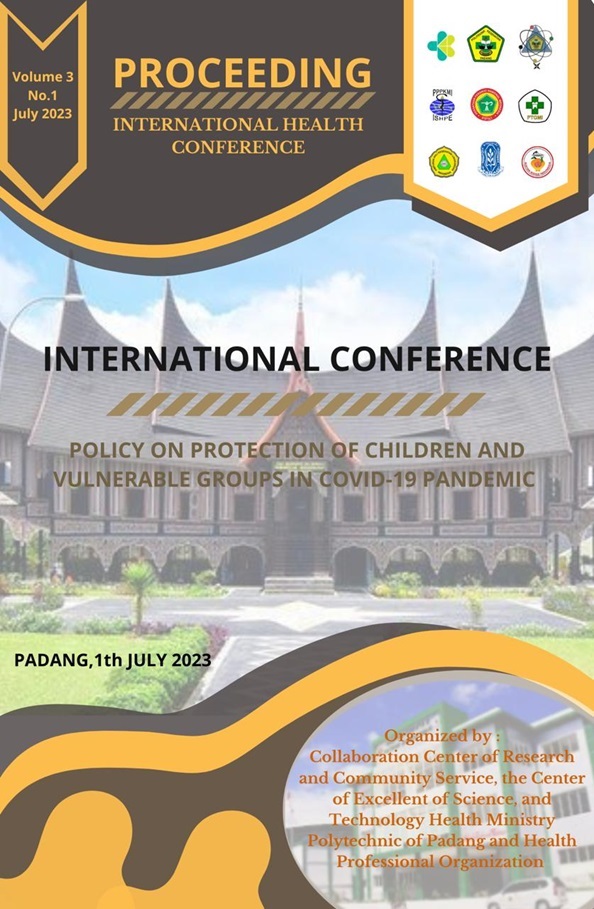Newborn Apgar Score in Terms of Prenatal Screening Results
Abstract
Pregnancy is part of the period of a woman's life. However, in pregnancy there are often unwanted complications. Complications or high risk in pregnancy estimated by 20% of pregnant women. The risk of the pregnancy developing into complications can be life- threatening. However, most complications can be prevented and managed if, the pregnant woman immediately seeks help from health workers and health workers are able to identify complications early. This study was conducted with an analytic cross sectional design at the BPM Working Area of Health Center the Kuranji Padang from July to November 2018. Research respondents were involved in total sampling, there were postpartum mothers within a span of three months after giving birth. The results of the screening were analyzed in relation to the APGAR score of newborns. The results showed that there was no significant difference in the mean of APGAR scores in the first and fifth minutes between mothers who had normal and abnormal blood pressure, weight gain, and uterine fundal height. There was a significant difference in the mean of APGAR scores in the first and fifth minutes between mothers who had normal and abnormal fetal movements and fetal heart rate. Birth status was the factor that has the greatest influence on the APGAR score of newborns. This study recommends the need for uniformity and completeness of data documentation by BPM in early detection of pregnant women and can provide integrated data to the Public Health Center so that the condition of pregnant women with high risk can be identified for further treatment.
Downloads
References
American Pregnancy Association. (2016). Prenatal testing. Diakses dari http://americanpregnancy.org/prenatal-testing/first-trimester-screen/
Cunningham, Melisa. (2017). New prenatal screening test could identify causes behind pregnancy complications. Diakses dari https://www.theage.com.au/national/victoria/new-prenatal-screening-test-could- identify-causes-behind-pregnancy-complications-20170830-gy7alb.html
Dinas Kesehatan Kota Padang, (2017). Profil Kesehatan Kota Padang Tahun 2016. DKK Padang
Fajarriyanti, I, N, (2017). Faktor-faktor yang mempengaruhi kejadian asfiksia neonanaturum di RSU PKU Muhammadiyah Bantul Tahun 2016-2017.
Kasliwal, A., Kabra, I., Yadav, P. (2021). Maternal and fetal outcome in premature rupture of membrane. Indian Journal of Obstetrics and Gynecology Research, 8 (3), 328-333
Murray, S.S. & McKinney, E.S. (2007). Foundations of maternal-newborn nursing. Vol.1. 4th ed. Singapore: Saunders
Oppenraaij, R.H.F.V, Jauniaux, E., Christiansen, O.B, Horcajadas, J.A., Farquharson, R.G., & Exalto, N. (2009). Predicting adverse obstetric outcome after early pregnancy events and complications: A review. Human Reproductive Update, 15 (4), 409-421
Pillitteri, A. (2010). Maternal & child health nursing: care of the childbearing & childrearing family. 6th ed. Philadelphia: Lippincot Williams & Wilkins
Prawirohardjo S. (2010). Ilmu Kebidanan. Jakarta: Yayasan Bina Pustaka Sarwono Prawirohardjo
Proverawati, Ismawati. (2010). Berat badan lahir rendah (BBLR). Yogyakarta: Nuha Medika.
Raharjo, C.A., Ngo, N.F, and Muhyi, A. (2021). Hubungan Kejadian Skor Apgar Kurang dari 7 dengan Faktor Risiko Ibu dan Persalinan di RSUD Abdul Wahab Sjahranie Samarinda Tahun 2018-2019. J. Sains Kes. 2021 Vol 3 No. 2, (302-309), p- ISSN: 2303-0267, e-ISSN: 2407-6082
Reeder, Martin, dan Griffin K. (2012). Keperawatan Maternitas: Kesehatan Wanita, Bayi & Keluarga. Alih bahasa Yati Afiyanti, Imami Nur Rachmawati, Sri Djuwitaningsih. Edisi 18. Vol.1. Jakarta: EGC
Sinuraya, R.K., Nisa, H., Lokajaya, T., dan Puri, T.N.S. (2017). Biomarker PIGF/sFlt- I sebagai pendeteksi dini Preeklampsia. Jurnal Farmasi Klinik Indonesia, 6 (2), 123- 134.
Widarta, G.D., Laksana, M.A.C., Sulistyono, A., & Purnomo W. (2015). Deteksi Dini Risiko Ibu Hamil dengan Kartu Skor Poedji Rochjati dan Pencegahan Faktor Empat Terlambat. Majalah Obstetri & Ginekologi, 23 (1), 28-32
Wong, D.L., Eaton, M.H., Wilson, D., Winkelstein, M., & Schwartz P. (2009). Buku Ajar Keperawatan Pediatrik. Jakarta; EGC.










